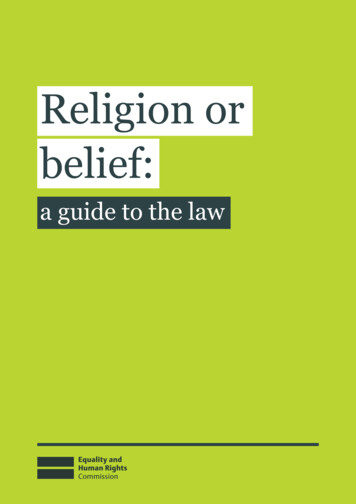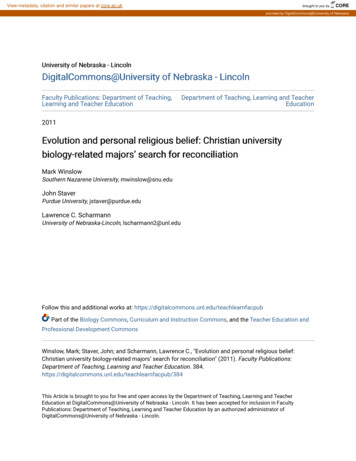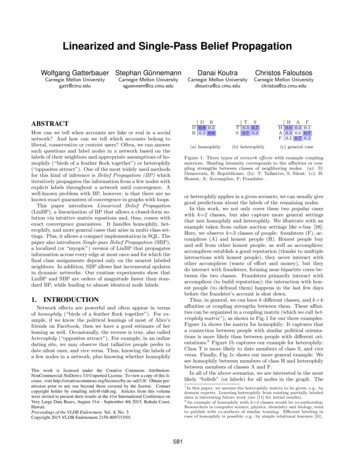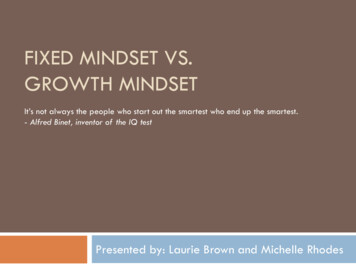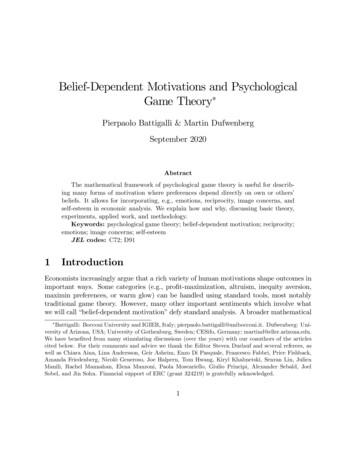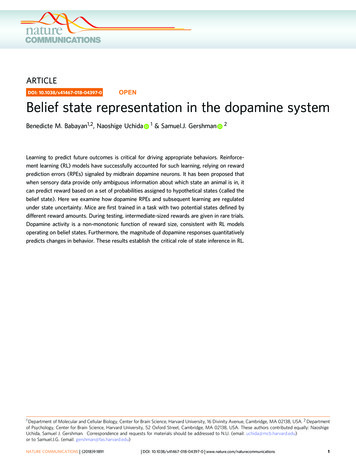
Transcription
ARTICLEDOI: 10.1038/s41467-018-04397-0OPENBelief state representation in the dopamine system1234567890():,;Benedicte M. Babayan1,2, Naoshige Uchida1& Samuel.J. Gershman2Learning to predict future outcomes is critical for driving appropriate behaviors. Reinforcement learning (RL) models have successfully accounted for such learning, relying on rewardprediction errors (RPEs) signaled by midbrain dopamine neurons. It has been proposed thatwhen sensory data provide only ambiguous information about which state an animal is in, itcan predict reward based on a set of probabilities assigned to hypothetical states (called thebelief state). Here we examine how dopamine RPEs and subsequent learning are regulatedunder state uncertainty. Mice are first trained in a task with two potential states defined bydifferent reward amounts. During testing, intermediate-sized rewards are given in rare trials.Dopamine activity is a non-monotonic function of reward size, consistent with RL modelsoperating on belief states. Furthermore, the magnitude of dopamine responses quantitativelypredicts changes in behavior. These results establish the critical role of state inference in RL.1 Department of Molecular and Cellular Biology, Center for Brain Science, Harvard University, 16 Divinity Avenue, Cambridge, MA 02138, USA. 2 Departmentof Psychology, Center for Brain Science, Harvard University, 52 Oxford Street, Cambridge, MA 02138, USA. These authors contributed equally: NaoshigeUchida, Samuel J. Gershman. Correspondence and requests for materials should be addressed to N.U. (email: uchida@mcb.harvard.edu)or to Samuel.J.G. (email: gershman@fas.harvard.edu)NATURE COMMUNICATIONS (2018)9:1891 DOI: 10.1038/s41467-018-04397-0 www.nature.com/naturecommunications1
ARTICLENATURE COMMUNICATIONS DOI: 10.1038/s41467-018-04397-0Dopamine neurons are thought to report a reward prediction error (RPE, or the discrepancy between observed andpredicted reward) that drives updating of predictions1–5.In reinforcement learning (RL) theories, future reward is predicted based on the current state of the environment6. Althoughmany studies have assumed that the animal has a perfectknowledge about the current state, in many situations the information needed to determine what state the animal occupies is notdirectly available. For example, the value of foraging in a patchdepends on ambiguous sensory information about the quality ofthe patch, its distance, the presence of predators, and other factorsthat collectively constitute the environment’s state.Normative theories propose that animals represent their stateuncertainty as a probability distribution or belief state7–10 providing a probabilistic estimate of the true state of the environmentbased on the current sensory information. Specifically, optimalstate inference as stipulated by Bayes’ rule computes a probabilitydistribution over states (the belief state) conditional on theavailable sensory information. Such probabilistic beliefs about thecurrent’s state identity can be used to compute reward predictionsby averaging the state-specific reward predictions weighted by thecorresponding probabilities. Similarly to the way RL algorithmsupdate values of observable states using reward prediction errors,state-specific predictions of ambiguous states can also be updatedby distributing the prediction error across states in proportion totheir probability. Simply put, standard RL algorithms computereward prediction on observable states, but under state uncertainty reward predictions should normatively be computed onbelief states, which correspond to the probability of being in agiven state.This leads to the hypothesis that dopamine activity shouldreflect prediction errors computed on belief states. However,direct evidence for this hypothesis remains elusive. Here weexamine how dopamine RPEs and subsequent learning areregulated under state uncertainty, and find that both are consistent with RL models operating on belief states.ResultsTesting prediction error modulation by belief state. Wedesigned a task that allowed us to test distinct theoreticalhypotheses about dopamine responses with or without stateinference. We trained 11 mice on a Pavlovian conditioning taskwith two states distinguished only by their rewards: an identicalodor cue predicted the delivery of either a small (s1) or a big (s2)reward (10% sucrose water) (Fig. 1a). The different trial typeswere presented in randomly alternating blocks of five identicaltrials, and a tone indicated block start. Only one odor and onesound cue was used for all blocks, making the two states perceptually similar prior to reward delivery. This task featureresulted in ambiguous sound and odor cues, since they werethemselves insufficiently informative of the block identity, rendering the two states ambiguous with respect to their identity.This feature increased the likelihood of mice relying on probabilistic state inference.To test for state inference influence on dopaminergic neuronsignaling, we then introduced rare blocks with intermediate-sizedrewards. Because the same odor preceded both reward sizes, astandard RL model with a single state would produce RPEs thatincrease linearly with reward magnitude (Fig. 1b, SupplementaryFig. 1a)11, 12. This prediction follows from the fact that the singlestate’s value will reflect the average reward across blocks, andRPEs are equal to the observed reward relative to this averagereward value. The actual value of the state will affect the interceptof the linear RPE response, but not its monotonicity. In Fig. 1band Supplementary Fig 1a, we illustrated our prediction with a2NATURE COMMUNICATIONS (2018)9:1891state st of average value 0.5 (on a scale between 0 and 1, whichwould be equivalent to 4.5 μL).A strikingly different pattern is predicted by an RL model thatuses state inference to compute reward expectations. Optimalstate inference is stipulated by Bayes’ rule, which computes aprobability distribution over states (the belief state) conditionalon the available sensory information. This model explicitlyassumes the existence of multiple states distinguished by theirreward distributions (see methods). Thus, in spite of identicalsensory inputs, prior experience allows to probabilisticallydistinguish several states (one associated to 1 μL and one to 10μL). If mice rely on a multi-state representation, they now havetwo reference points to compare the intermediate rewards to.Upon the introduction of new intermediate rewards, theprobability of being in the state s1 would be high for small wateramounts and low for large water amounts (Fig. 1c). Thesubsequent reward expectation would then be a probabilityweighted combination of the expectations for s1 and s2.Consequently, smaller intermediate rewards would be better thanthe expected small reward (a positive prediction error) and biggerintermediate rewards would be worse than the expected bigreward (a negative prediction error), resulting in a nonmonotonic pattern of RPEs across intermediate rewards (Fig. 1d,Supplementary Fig. 1c).In our paradigm, because reward amount defines states, rewardprediction and belief state are closely related. Yet with the samereward amount, standard RL and belief state RL makequalitatively different predictions (Fig. 1b, d). The maindistinction between both classes of models is the following: thestandard RL model does not have distinct states corresponding tothe small and large reward states, and reward prediction is basedon the cached value learned directly from experienced reward,whereas the belief state model has distinct states corresponding tothe small and large reward states (Supplementary Fig. 1, leftcolumn). In the latter case, the animal or agent uses ambiguousinformation to infer which state it is in, and predicts reward basedon this inferred state (i.e., belief state).To test whether dopamine neurons in mice exhibitedthis modulation by inferred states, we recorded dopamineneuron population activity using fiber photometry (fluorometry)(Fig. 1e)13–16. We used the genetically encoded calcium indicator,GCaMP6f17, 18, expressed in the ventral tegmental area (VTA) oftransgenic mice expressing Cre recombinase under the control ofthe dopamine transporter gene (DAT-cre mice)19 crossed withreporter mice expressing red fluorescent protein (tdTomato)(Jackson Lab). We focused our analysis on the phasic responses.Indeed, calcium imaging limits our ability to monitor longtimescale changes in baseline due to technical limitations such asbleaching of the calcium indicator. Moreover a majority ofprevious work studying dopamine neurons has shown rewardprediction error-like signaling in the phasic responses1, 3, 12.Similarly to single-cell recordings1, 3, 12, population activity ofdopamine neurons measured by fiber photometry in the VTA20(Supplementary Fig. 2) or in terminals of dopamine neuronsprojecting to the ventral striatum16, 21 show canonical RPEcoding in classical conditioning tasks.Behavior and dopamine neuron activity on training blocks.After training mice on the small (s1 1 µL) and big (s2 10 µL)states, we measured their amount of anticipatory licking, a readout for reward expectation, and the dopamine responses (Fig. 2a,d). At block transitions, mice had a tendency to anticipate achange in contingency as they increased anticipatory licking intrial 1 following a small block (one sample t-tests, p 0.05,Fig. 2b), leading to similar levels of anticipatory licking on trial 1 DOI: 10.1038/s41467-018-04397-0 www.nature.com/naturecommunications
ARTICLENATURE COMMUNICATIONS DOI: s100.5Belief state: b P (s s1 r )dOptic fiberDetectorVTAReward (r )GCaMP6f, tdTomatoDAT-cre mouse r -V(b)0.5RPE1b1–0.5?What is the current state?cLaserDetector?s1e r -V(s)0.50.5000.500.51–0.51Reward (r )Reward (r )Fig. 1 Task design to test the modulation of dopaminergic RPEs by state inference. a Mice are trained on two perceptually similar states only distinguishedby their rewards: small (s1) or big (s2). The different trial types, each starting by the onset of a unique odor (conditioned stimulus, CS) predicting thedelivery of sucrose (unconditioned stimulus, US), were presented in randomly alternating blocks of five identical trials. A tone indicated block start. Onlyone odor and one sound cue were used for all blocks, making the two states perceptually similar prior to reward delivery. To test for state inferenceinfluence on dopaminergic neuron signaling, we then introduced rare blocks with intermediate-sized rewards. Using (with reinforcement learning (RL)operating on belief states) or not (with standard RL) the training blocks as reference state for computing the value of the novel intermediate states predictscontrasting RPE patterns (b vs d). b RPE across varying rewards computed using standard RL. Because the same odor preceded both reward sizes, astandard RL model with a single state would produce RPEs that increase linearly with reward magnitude. c Belief state b across varying rewards defined asthe probability of being in s1 given the received reward. d RPE across varying rewards computed using the value of the belief state b. A non-monotonicpattern across increasing rewards is predicted when computing the prediction error on the belief state b. e (Top) Population activity of VTA dopaminergicneurons is recorded in behaving mice using fiber photometry. (Bottom) Fiber location above the recorded cells in the VTA, which co-express the calciumreporter GCaMP6f and the fluorescent protein tdTomato (scale bar: 200 μm)(two-way ANOVA, no effect of current or previous block, p 0.16; Fig. 2a, c). The dopamine response on cue presentation didnot show such modulation, only reflecting the activity on theprevious trial (one sample t-tests, p 0.27, Fig. 2e; two-wayANOVA, main effect of previous block on trial 1, p 0.0025,Fig. 2f), although the response on reward presentation showedmodulation by both the current and previous block (two-wayANOVA on trial 1, main effect of current block, p 0.001, maineffect of previous block, p 0.038, Fig. 2h), with significantchanges in amplitude at block transitions for block s1 following s2and blocks s2 (one sample t-tests, p 0.01, Fig. 2g).Analyzing the licking and dopamine activity at block start,when the sound comes on, mice appeared to increase lickingfollowing the small block s1 between sound offset and trial 1’sodor onset (during a fixed period of 3 s) (SupplementaryFig. 3a, b). Although this was not sufficient to actually reversethe licking pattern on trial start, it likely contributed to theobserved change in licking between trial 5 and 1 (Fig. 2b).Dopamine activity showed the opposite tendency, with decreasingactivity following blocks s2 (Supplementary Fig. 3c, d). Thisactivity on block start indicated that mice partially predicted achange in contingency, following the task’s initial trainingstructure (deterministic switch between blocks during the first10 days). However, this predictive activity did not override theeffect of the previous block on dopamine activity on cuepresentation as it was most similar to the activity on thepreceding block’s last trial (Fig. 2e). Following trial 1, anticipatorylicking and dopamine activity on cue and reward presentationreached stable levels, with lower activity in s1 compared to s2(two-way ANOVAs, main effect of current block on trials 2 to 5,p 0.05, no effect of previous block, p 0.4, nor interaction, p 0.5; Fig. 2c, f, h). The stability in anticipatory licking anddopamine activity after exposure to the first trial of a blockNATURE COMMUNICATIONS (2018)9:1891suggested that mice acquired the main features of the task: rewardon trial 1 indicates the current block type and reward is stablewithin a block.Dopaminergic and behavioral signature of belief states. Oncemice showed a stable pattern of licking and dopamine neuronactivity in the training states (Fig. 2), every other training day wereplaced 10% of the training blocks (3) by intermediate rewardblocks, with each intermediate reward being presented no morethan once per day. Over their whole training history, each mouseexperienced 3980 213 (mean s.e.m.) trials of each trainingblock and 42 6 (mean s.e.m.) trials of each intermediatereward (Supplementary Fig. 4). On the first trial of reward presentation, the dopamine neurons responded proportionally toreward magnitude (Fig. 3a–c). Importantly, the monotonicallyincreasing response on this first trial, which informed mice aboutthe volume of the current block, suggested dopamine neuronshad access to the current reward. On the second trial, theresponse of dopamine neurons presented a non-monotonic pattern, with smaller responses to intermediate rewards (2 and 4 µL)than to bigger intermediate rewards (6 and 8 µL) (Fig. 3e, f, g).These monotonic and non-monotonic patterns on trials 1 and2, respectively, were observed in our three different recordingconditions: (1) in mice expressing GCaMP6f transgenetically inDAT-positive neurons and recorded from VTA cell bodies (n 5), (2) in mice expressing GCaMP6f through a viral construct inDAT-positive neurons and recorded from VTA cell bodies (n 2); (3) in mice expressing GCaMP6f through a viral construct inDAT-positive neurons and recorded from dopamine neuronterminals in the ventral striatum (n 4) (SupplementaryFig. 5a–c). Although these patterns were observed in eachcondition, the amplitude of the signal varied across the differentrecording conditions, largely due to lower expression levels of DOI: 10.1038/s41467-018-04397-0 www.nature.com/naturecommunications3
ARTICLENATURE COMMUNICATIONS DOI: 10.1038/s41467-018-04397-0BehavioraTrial 2Trial 1OdorLick/s8Trial 3Odor88024Time (s)42Time (s)06842Time (s)6Odor40006Trial 5Odor40008444Trial 4Odor042Time (s)6024Time (s)6Odor response (CS)bcWithin blocks5**Block s1 (1 μL), previous s140.4Lick/s0Block s1 (1 μL), previous s23Block s2 (10 μL), previous s12Block s2 (10 μL), previous s21–0.401dTrial 1dF/F (%)3Trial45Trial 2Odor62Odor66Dopamine neuronsTrial 3Odor66444442222200000042Time (s)42Time (s)060642Time (s)06Odor response (CS)At block transitionf0.5gWithin blocks0.8dF/F (%)0.600.40.20–0.5142Time (s)Odor0642Time (s)6Reward response (US)ΔdF/F (%) (trial 1– trial 5)eΔdF/F (%) (trial 1– trial 5)Trial 5Trial 4Odor23Trial45At block transitionh*42*0Within blocks4dF/F (%)Δ lick rate (trial 1– trial 5)At block transition0.820–2*123Trial45Fig. 2 Behavior and dopamine neuron activity on training blocks s1 and s2. a Licking across the five trials within a block. Anticipatory licking quantificationperiod during odor to reward delay is indicated by the horizontal black line. b Anticipatory licking at block transition increases when transitioning from thesmall to the big block. c Anticipatory licking across trials within blocks. Anticipatory licking on trial 1 is similar across all block types then stabilizes at eitherlow or high rates for the following four trials. d Dopamine neuron activity across the five trials within a block. Horizontal black line indicates quantificationperiod for odor (CS) and reward (US) responses. e Dopamine neurons odor response across block transitions is stable. f Dopamine neurons odor responseacross trials. Dopamine activity adapts to the current block value within one trial. g Dopamine neurons reward response shows an effect of the currentreward and previous block on trial 1. h Dopamine neurons reward response across trials. Dopamine activity reaches stable levels as from trial 2. Datarepresents mean s.e.m. *p 0.05 for t-test comparing average value to 0. n 11 miceGCaMP in transgenic mice compared to those with viralexpression and overall variability in signal intensity acrossanimals within each recording condition. Therefore, for illustration purposes, we normalized the signals from each individualmouse using trial 1’s response as reference for the minimum andmaximum values for the min–max normalization (y (x mintrial1)/(maxtrial1 mintrial1)) to rescale the GCaMP signals inthe 0 to 1 range (Supplementary Fig. 5d–f, Figs. 3 and 4). Similar4NATURE COMMUNICATIONS (2018)9:1891results were obtained when measuring the peak responsefollowing reward presentation instead of the average activityover 1 s (Supplementary Fig. 6a–g).We compared the fits of linear and polynomial functions to thedopamine responses, revealing highest adjusted r2 for a linear fitfor trial 1 (Supplementary Fig. 7a) and for a cubic polynomial fitfor trial 2 (Supplementary Fig. 7b). The non-monotonic patternobserved on trial 2 was consistent with our hypothesis of belief DOI: 10.1038/s41467-018-04397-0 www.nature.com/naturecommunications
ARTICLENATURE COMMUNICATIONS DOI: 10.1038/s41467-018-04397-0Dopamine neuronsBehaviorTrial 110.5c1.510.500n 1–0.5012Time (s)n 11 23468Reward (μL)d10.80.60.40.2n 110101 2468Reward (μL)Δ lick rate (trial 2 – trial 1)dF/F (%)1.5bNormalized dF/F (%)1 μL2 μL4 μL6 μL8 μL10 μL2dF/F (%)a210–1n 11–2101 2468Reward (μL)1 2468Reward (μL)10Trial 2g0.50n 1–0.5012Time (s)3Normalized dF/F (%)1.510.50n 11 2468Reward (μL)10h10.80.60.40.2n 1101 2468Reward (μL)Δ lick rate (trial 3 – trial 2)f1dF/F (%)dF/F (%)e210–1n 11–21010Fig. 3 Dopaminergic and behavioral signature of belief states. a–c Dopamine neurons activity on trial 1. Dopamine neurons show a monotonically increasingresponse to increasing rewards (a, individual example), quantified as the mean response after reward presentation (0–1 s, indicated by a solid black line ina) in the individual example (b) and across mice (c). d Change in anticipatory licking from trial 1 to trial 2. Mice increase their anticipatory licking after trial 1proportionally to the increasing rewards. e–g Dopamine neurons activity on trial 2. Dopamine neurons show a non-monotonic response pattern toincreasing rewards (e, f, individual example), quantified across all mice (g). h Change in anticipatory licking from trial 2 to trial 3. Whereas mice do notadditionally adapt their licking for the known trained volumes (1 and 10 μL) after trial 2, they increase anticipatory licking for small intermediate rewards anddecrease it for larger intermediate rewards in a pattern, which follows our prediction of belief state influence on RPE. n 11, data represent mean s.e.m.state influence on dopamine reward RPE (Fig. 1d). We focusedour analysis on trial 2 since, according to our model, that is themost likely trial to show an effect of state inference with thestrongest difference from standard RL reward prediction errors(Supplementary Fig. 8a, b). Both RL models predict weakerprediction error modulation with increasing exposure to the samereward and we observed weaker versions of this non-monotonicpattern in later trials (Supplementary Fig. 8a, c). It is howeverinteresting to note that different mice showed a non-monotonicreward response modulation at varying degrees on distinct trials.For example, Mouse 4 showed a strong non-monotonic patternon trial 2, which then became shallower on the following trials,whereas Mouse 9 showed a more sustained non-monotonicpattern across trials 2 to 5 (Supplementary Fig. 8d). Lastly, thepattern of dopamine responses was observed independently of thebaseline correction method we used, whether it was pre-trial, preblock, or using a running median as baseline (SupplementaryFig. 9).We next analyzed whether behavior was influenced by stateinference. Anticipatory licking before reward delivery is a readout of mice’s reward expectation. Dopamine RPEs are proposedto update expectations. To test whether mice’s behavioraladaptation across trials followed the dopaminergic RPE pattern,we measured how mice changed their anticipatory licking acrosstrials. From trial 1 to trial 2, mice changed their anticipatorylicking proportionally to the volume (Fig. 3d) but showed a nonmonotonic change from trial 2 to trial 3 (Fig. 3h; highest adjustedr2 for a cubic polynomial fit, Supplementary Fig. 7d). Fits of linearand polynomial functions to the change in anticipatory lickingrevealed highest adjusted r2 for cubic polynomial fits for bothtransitions from trial 1 and 2 (Supplementary Fig. 7c), althoughNATURE COMMUNICATIONS (2018)9:1891the linear fit still provided a decent fit (adjusted r2 0.94). Thus,dopamine activity and change in anticipatory licking both showedmodulation according to our prediction of the influence of beliefstate on RPE (Fig. 1d). Although the average change inanticipatory licking for transitions from trial 3 to 5 did not seemto visibly follow the pattern of dopamine activity (SupplementaryFig. 10a), a trial-by-trial analysis showed that dopamine responseson reward presentation were significantly correlated with achange of licking on following trial for all trial transitions withinblocks (trial 1 to 5, Pearson’s r, p 2.5 10 3, SupplementaryFig. 10b), suggesting that inhibition or lower activations ofdopamine neurons were more often followed by a decrease inanticipatory licking whereas transient activations of dopamineneurons tended to be followed by increased anticipatory licking.Belief state RL explains dopamine responses and behavior. Wenext tested whether an RL model operating on belief states couldexplain the dopamine recordings better than a standard RLmodel. As the odor indicating trial start was identical for allreward sizes, a standard RL model (without belief states) wouldassume a single state, with prediction errors that scale linearlywith reward (Supplementary Fig. 1a). An RL model using beliefstates, by contrast, differentiates the states based on the currentreward size and the history of prior reward sizes within a block(Supplementary Fig. 1c). Belief states were defined as the posterior probability distribution over states given the reward history,computed using Bayes’ rule (Methods). Since the previous blockhad an effect on the expectation of the first trial of a given block(Fig. 2), we allowed for two different initial values on block startdepending on the previous block in both models, and fit RLmodels to the trial-by-trial dopamine response of each trained DOI: 10.1038/s41467-018-04397-0 www.nature.com/naturecommunications5
ARTICLENATURE COMMUNICATIONS DOI: 10.1038/s41467-018-04397-0Dopamine neuron activity model fitsNormalized dopamineresponsea1bTrial 1n 11Trial 210.80.80.60.60.40.40.20.20n 11DataStandard reinforcementlearningReinforcement learningwith belief state01 24 6 8Reward (μL)101 24 6 8Reward (μL)10Model predictions on behaviourAll trialsdTrial 2 - Mouse 1Trial 2 - Mouse 2130.750.2500 0.25 0.5 0.75 1Standard reinforcementlearning model Reinforcement learning withbelief state model correlationsc0001 2468Reward (μL)101 2468Reward (μL)10Fig. 4 RL with belief states explains dopamine reward responses and behavior better than standard RL. Individual DA responses to rewards were fit usingeither a standard RL model or a RL model computing values on belief states. a Fits to dopamine responses on trial 1. Both RL models fit the dopamineresponse, since on trial 1 there is no evidence to infer a state on. b Fits to dopamine responses on trial 2. Only computing RPEs using belief statesreproduced the non-monotonic change in dopamine response across increasing rewards. c Model predictions on behavior. The value functions from eithermodel fits were positively correlated with the mice’s anticipatory licking, but the RL model with belief state provided a better fit (signed rank test: p 0.032), suggesting that mice’s anticipatory licking tracks the value of the belief state. d Individual examples of extracted value function from either modeland anticipatory licking across increasing rewards on trial 2. n 11, data represent mean s.e.m.mouse across all trials (Supplementary Fig. 1b, e). On trial 1, bothmodels predicted and fit the linearly increasing dopamineresponse to increasing rewards (Fig. 4a). On trial 2, only RPEscomputed on belief states reproduced the non-monotonic changein dopamine response across increasing rewards (Fig. 4b). Weadditionally tested four model variants, two that did not includeinfluence from the previous block on the value for the standardRL model (Supplementary Fig. 1a) or on the prior at block startfor the belief state model (Supplementary Fig. 1c), as well as twoother variants of the belief state RL model with distinct priorsbased on the previous block (Supplementary Fig. 1d) or withthree states, adding a belief state for the intermediate rewards(Supplementary Fig. 1f). Overall, only models computing prediction errors on belief states could qualitatively reproduce thenon-monotonic pattern of dopamine activity on trial 2 (Supplementary Fig. 1g–l). Bayesian information criterion (BIC) andrandom-effects model selection22, 23 computed on each of the sixmodels fit to individual mice’s dopamine activity both favored theRL model with belief states with two initial free priors over othermodels, in particular over the standard RL model with two freeinitial values (Supplementary Table 1; Supplementary Fig. 8c).Similar results were obtained when fitting the peak GCaMPresponse after reward presentation (Supplementary Table 2;Supplementary Fig. 6h).Since anticipatory licking in the training blocks reflected thevalue of each training block (Fig. 2c), we next examined therelationship between anticipatory licking and values in the RLmodels, with or without belief states, which obtained the bestmodel comparison scores (BIC and protected exceedanceprobability). The models were not fit to these data and hencethis constitutes an independent test of the model predictions. Foreach mouse, anticipatory licking in all trials and all reward sizes6NATURE COMMUNICATIONS (2018)9:1891was positively correlated with values extracted from both RLmodels (one-tailed t-test, p 1.0 10 6), but the correlations weresignificantly higher with the values computed using a RL modelwith belief state (Fig. 4c; Signed rank test, signed rank 9, p 0.032), and as shown in two individual examples (Fig. 4d).Although we only fit the model RPEs to the dopamine rewardresponse, the belief state values used to compute the error termwere apparent in the anticipatory licking activity. Finally, weperformed the same analysis on the dopamine response at cueonset (Supplementary Fig. 11). Dopamine activity at cue onsetappeared to follow a step function on trials 2 to 5 acrossincreasing rewards (Supplementary Fig. 11a), similar to thepredicted belief state value (Supplementary Fig. 1c–f). Thisactivity was positively correlated with values from both models(one-tailed t-test, p 1.0 10 3, Supplementary Fig. 11b),although no model was a significantly better predictor (Signedrank test, signed rank 21, p 0.32).DiscussionOur results suggest that mice make inferences about hidden statesbased on ambiguous sensory information, and use these inferences to determine their reward expectations. In our task design,this results in a non-monotonic relationship between rewardmagnitude and RPE, reflected in the response of dopamineneurons. Although this pattern is strikingly different from thepatterns observed in classical conditioning studies12, 24, 25, it canbe qualitatively and quantitatively accommodated by a model inwhich RPEs are computed on belief states. Our results complement recent studies that have provided additional evidence forreflections of hidden-state inference in dopamine responses, forexample when animals learn from ambiguous temporal26–28 andvisual29 cues. DOI: 10.1038/s41467-018-04397-0 www.nature.com/naturecommunications
ARTICLENATURE COMMUNICATIONS DOI: 10.1038/s41467-018-04397-0Two features of our task design allowed us to specifically testthe influence of belief states on dopamine RPE: an extendedtraining on two reference states, which allowed mice to build astrong prior over reward distributions, and ambiguity in the cuesused to signal upcoming reward c
whereas the belief state model has distinct states corresponding to the small and large reward states (Supplementary Fig. 1, left column). In the latter case, the animal or agent uses ambiguous information to infer which state it is in, and predicts reward based on this inferred state (i.e., belief state).



